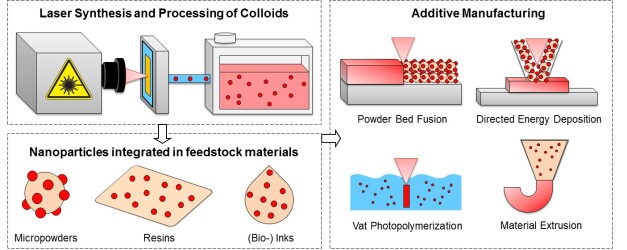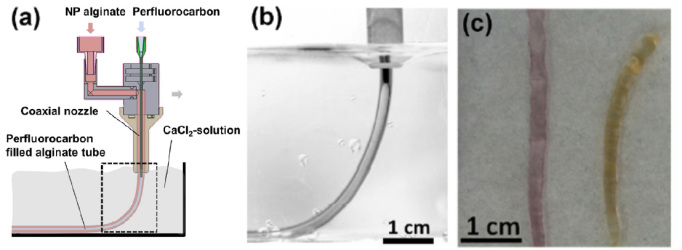Materials for Additive Manufacturing
Materials for Additive Manufacturing
Additive manufacturing (AM) is becoming more and more important. The possibilities of this technology seem to be limitless as demonstrated by the complex geometries produced by methods such as Laser Powder Bed Fusion (L-PBF), Directed Energy Deposition (DED), Stereolithography (SLA) and Biomaterialextrusion. In the past, these methods were mainly used for the production of small series and prototypes. However, this technology is currently being introduced and implemented into series production. Therefore, the material properties have to be adapted to the new challenges, this is where we come in.

In the research line of “materials for additive manufacturing” we focus on the development of new composite materials for additive manufacturing. Practically, our research strategy embeds nanoparticles into AM feedstock materials. This approach follows the idea of “nano-integration”, where nano-functionalities are integrated into raw materials, easily processable by standard AM technologies such as Laser Powder Bed Fusion of polymers [1] and metals [2, 3], Direct Energy Deposition via laser cladding [5], Stereolithography or two-photon-polymerization 2PP [6], laser writing [7], and bioprinting [8]. In these AM processes, feedstock material nano-doping aims at improvements of processability [1, 9], mechanical [2-3,5], optical [1, 9], or biomedical [8] properties. More details and examples are given below, sorted by material class (metals, polymers, ceramics/semiconductors, bioinks/biomaterials). For further information and contact details, see Ziefuß group (magnets, CRC 270, tech applications) and Rehbock Group (bio-applications).
1) Metals (for L-PBF, DED and laser writing)

Research activities on metal additive manufacturing include the modification of tool steel powders with WC and TiO2 nanoparticles to improve the performance of the L-PBF built part regarding mechanical and wear properties. [2] By decorating steel powder that are used in high temperature applications with yttria nanoparticles, we further demonstrate the feasibility of oxide-dispersion strengthened (ODS) alloys by DED [5] and L-PBF [3,4]. Micro-laser-sintering of shape-memory alloys has been addressed from the bio-applicability point of view at the example of an AM-built NiTi actuator [10], as synopsis towards 4D AM.
Another direction that is pursued in our projects within the framework of the CRC/TRR 270 "Hysteresis design of magnetic materials for efficient energy conversion" is the material design for 3D-printed magnets. Besides the permanent magnet design based on NdFeB (and its substitutes) via L-PBF, the magnetocaloric material LaFeSi is addressed via nanoparticle-ink-writing, similar to microparticle-ink-writing of conductive lines [7].
2) Polymers (for L-PBF and SLA)

The Deutsche Forschungsgemeinschaft (DFG) established the Priority Programme “Materials for Additive Manufacturing” SPP 2122 [11,12], with currently over 20 research groups in Germany involved in this SPP, specifically working on the development of new metal and polymer powders. This program is dedicated to laser-and powder-based AM. In this context, our group works on the synthesis of new polymer powders for L-PBF. The modification of L-PBF powder materials by nanoadditives offers the possibility to adapt the powder properties to the laser sintering process or the resulting part properties. To avoid agglomeration of the nanofiller, a new approach is demonstrated in which surfactant-free, laser-generated colloidal nanoparticles are adsorbed onto the polymer surface via wet impregnation. This method yields micropowders, decorated with highly dispersed nanoparticles on their surface [1]. Based on this effective approach, polymer powders such as thermoplastic polyurethane TPU and polyamide 12 (PA12) are decorated with metal and oxide nanoparticles and processed via L-PBF [1].
For polymer resins, the nano-integration process works as well, doping the resin feedstock material. Examples include the modificiation of the optical response of photopolymers used in SLA by integrating plasmonic gold nanoparticles into the polymer and replacing commercial photoinitiators [6].
3) Ceramics / Semiconductors (for L-PBF)
![]()
In this research line, we work on the off-resonant near-field enhancement of ceramic powders by plasmonic nanoparticles. We show that gold nanoparticles adsorbed on crystalline zinc oxide significantly increase the energy efficiency of infrared laser sintering. At the same time, the plasmonic antennas are embedded into the manufactured part´s oxide matrix. In this way, the enhanced laser sintering process with ligand-free nanoparticles gives access to metal–semiconductor hybrid materials with potential application in light harvesting or energy conversion [9].
4) Biomaterials/Bioinks (for Bioextrusion and Bioprinting)

In the field of biomaterials, bioextrusion of alginates is an AM process known to be compatible to cell-laden biofabrication. Nanoparticle-filled, thin-walled alginate tubes are printed, measuring several centimeters in length. Nanoparticle doping is achieved in the feedstock printing ink, with particles homogeneously distributed in the 3D part [8]. The embedding of iron nanoparticles showed quite beneficial properties for endothelialisation of the nano-doped alginate, already volume loads of only 70 ppm iron [8], and similar entothelisalisation effects were achieved in nano-doped TPU, aiming to improve the hemocompatibility of medical devices and artificial organs [13]. The general suitability of nano-doped hydrogels as active biomaterial for wound healing was assessed in cytocompatibility, cell proliferation, and migration assays using human dermal fibroblasts and keratinocytes [14]. The hydrogels were processed via electrospinning resulting in a centimeter scale, fully cytocompatible fiber pad for wound coverages [14]. Such gel-based nano-doped biomaterials, processed by 3D printing, are also interesting for the fabrication of RGD-peptide-free scaffolds for tissue engineering, or studies on the differentiation of stem cells in their ion-controlled niche.
References:
[1] A new approach to coat PA12 powders with laser-generated nanoparticles for selective laser sintering.
T. Hupfeld, T. Laumer, T. Stichel, T. Schuffenhauer, J. Heberle, M. Schmidt, S. Barcikowski, B. Gökce
Procedia CIRP 74C, 244 (2018) https://doi.org/10.1016/j.procir.2018.08.103
[2] Laser powder bed fusion of nano-WC-modified and nano-TiO2-modified metal powders.
J. T. Sehrt, S. Kleszczynski, C. Notthoff, M. Lau, B. Gökce, S. Barcikowski
Proceedings of International Conference on Additive Technologies 28, 26 (2016) https://www.researchgate.net/publication/316316942_Laser_powder_bed_fusion_of_nano-WC-modified_and_nano-TiO2-modified_metal_powders
[3] Laser additive manufacturing of oxide dispersion strengthened steels using laser-generated nanoparticle-metal composite powders.
M. B. Wilms, R. Streubel, F. Frömel, A. Weisheit, J. Tenkamp, F. Walther, S. Barcikowski, J. H. Schleifenbaum, B. Gökce
Procedia CIRP 74C, 196 (2018) https://doi.org/10.1016/j.procir.2018.08.093
[4] Use of (nano-)additives in Laser Powder Bed Fusion of AI powder feedstocks: research directions within the last decade
I.M. Kusoglu, B. Gökce, S. Barcikowski
Procedia CIRP 94C, 11 (2020) https://doi.org/10.1016/j.procir.2020.09.003
[5] Oxide dispersion-strengthened alloys generated by laser metal deposition of laser-generated nanoparticle-metal powder composites.
C. Doñate-Buendía, F. Frömel, M. B. Wilms, R. Streubel, J. Tenkamp, T. Hupfeld, M. Nachev, E. Gökce, A. Weisheit, S. Barcikowski, F. Walther, J. H. Schleifenbaum, B. Gökce
Materials & Design 154, 360 (2018) https://doi.org/10.1016/j.matdes.2018.05.044
[6] Plasmon assisted 3D microstructuring of gold nanoparticle-doped polymers.
L. Jonusauskas, M. Lau, P. Gruber, B. Gökce, S. Barcikowski, M. Malinauskas, A. Ovsianikov
Nanotechnology 27, 154001 (2016) https://doi.org/10.1088/0957-4484/27/15/154001
[7] Effect of various dispersing agents on the stability of silver microparticle dispersionand the formulation of uniform silver film by laser melting
A. Letzel, E. Maurer, M. Meixner, R. Poprawe, J. Stollenwerk, S. Hessner, K. Lehmann, B. Gökce, S. Barcikowski
Journal of Laser Applications 28, 042004 (2016) https://doi.org/10.2351/1.4955011
[8] Laser-based in situ embedding of metal nanoparticles into bioextruded alginate hydrogel tubes enhances human endothelial cell adhesion
A. Blaeser, N. Million, D.F.D. Campos, L. Gamrad, M. Koepf, C. Rehbock, M. Nachev, B. Sures, S. Barcikowski, H. Fischer
Nano Res., 9 (2016) 3407-3427. https://link.springer.com/article/10.1007/s12274-016-1218-3
[9] Near-field-enhanced, off-resonant laser sintering of semiconductor particles for additive manufacturing of dispersed Au-ZnO-micro/nano hybrid structures.
M. Lau, R.G. Niemann, M. Bartsch, W. O’Neill, S. Barcikowski
Applied Physics A 114 (2014), Nr. 4, S. 1023-1030 https://link.springer.com/article/10.1007/s00339-014-8270-1
[10] Induction of Osteogenic Differentiation of Adipose Derived Stem Cells by Microstructured Nitinol Actuator-Mediated Mechanical Stress.
S. Strauss, S. Dudziak, R. Hagemann, S. Barcikowski, M. Fliess, M. Israelowitz, D. Kracht, J. W. Kuhbier, C. Radtke, K. Reimers, P.M. Vogt
PLOS ONE 7, 12 (2012) https://doi.org/10.1371/journal.pone.0051264
[11] Materials for Photonics.
B. Gökce, S. Barcikowski, P. Behrens, U. Fritsching, I. Kelbassa, R. Poprawe, C. Esen, A. Ostendorf, B. Voit
Laser+Photonics (2016), 6-10 https://www.researchgate.net/publication/299393488_Materials_for_Photonics
[12] Laser powder bed fusion of polymers : Quantitative research direction indices
I.M. Kusoglu, C. Doñate-Buendía, S. Barcikowski, B. Gökce
Materials 14(5) (2021) https://doi.org/10.3390/ma14051169
[13] Dose-dependent surface endothelialization and biocompatibility of polyurethane noble metal nanocomposites.
Hess, C. ; Schwenke, A. ; Wagener, P. ; Franzka, S. ; Sajti, C. L. ; Pflaum, M. ; Wiegmann, B. ; Haverich, A. ; Barcikowski, S
Journal of Biomedical Materials Research, Part A 102 (2014), 6, 1909-1920 https://doi.org/10.1002/jbm.a.34860
[14] Water-based, surfactant-free cytocompatible nanoparticle-microgel-composite biomaterials – rational design by laser synthesis, processing into fiber pads and impact on cell proliferation.
N. Million, V. Coger, P. Wilke, C. Rehbock, M. Vogt Peter, A. Pich, S. Barcikowski
BioNanoMaterials, 2017. https://doi.org/10.1515/bnm-2017-0004
